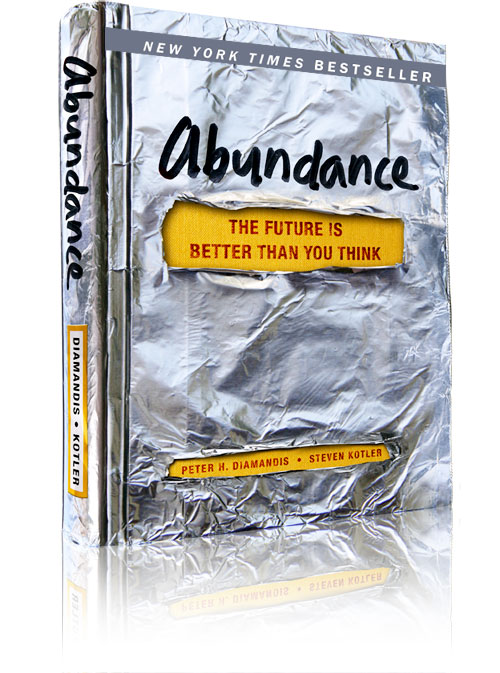One of the big inspirations for the MixedRealities blog is the book Race against the machine, written by the MIT-researchers Erik Brynjolfsson and Andrew McAfee. These last few days I’ve read another book about globalization and exponentially growing technologies, Abundance, The Future Is Better Than You Think, by the engineer and entrepreneur Peter H. Diamandis and journalist/entrepreneur Steven Kotler.
I wrote a column (in Dutch) about the book and the reaction of our newspaper community during a chat session, but here I’ll give more a ‘MixedRealities-take’.
Our brains are hard wired to be in constant alert, changes around us can always be catastrophic. This is useful when your life is constantly threatened by predators, but in a contemporary society it makes us far too pessimistic. It makes us look foremost at the dangers and the negative news while we downplay positieve news.
 In the meantime we evolved from beings with a very local horizon and a linear technological evolution to people living in a world defined by global collaboration and an exponential evolution of key technologies. Diamandis gives a very positive, even exhilirating view on developments in sectors such as biotech and bio-informatics, nanotechnology, computer networks, robotics and sensors, pharma and education.
In the meantime we evolved from beings with a very local horizon and a linear technological evolution to people living in a world defined by global collaboration and an exponential evolution of key technologies. Diamandis gives a very positive, even exhilirating view on developments in sectors such as biotech and bio-informatics, nanotechnology, computer networks, robotics and sensors, pharma and education.
Small and highly innovative teams accomplish breakthroughs, eventually stimulated by prize competitions and with a considerable push in the back by techno-philantropists. But there’s also the ‘bottom of the pyramide’, the one billion poor who are doing better because of technologies such as mobile communication and microfinance-institutions. Those people represent not only a new market, but their needs lead to innovations which are applicable elsewhere (like the manufacturing of ultra-cheap cars or the use of distributed energy production).
Education, international collaboration, telepresence, knowledge networks and the organization of small teams of innovators are subjects about which MixedRealities wants to post on a regular basis. The blog starts about five years ago with a firm focus on virtual worlds, and I’ll continue writing about those environments but in the broader context I mentioned above.
Even though Abundance is exhilirating optimistic, the authors do recognize the challenges ahead. 3D printing can help small teams to engage in the production of goods on a worldwide level, challenging multinational companies. But it can also be used by other small teams to collaborate in the production of weapons of mass destruction. The same applies for biotech labs, which become ever more affordable, but also this DIY-revolution can be used for destructive purposes. Or nanotechnology, which could lead to massive destruction of matter – the grey goo scenario.
The solution for all this is not less technology, but more. The restrictions on stem cell research in the US did not end that research, it simply moved abroad. It appears to be impossible to stop the technological evolution – even world wars, revolutions and financial meltdowns don’t stop technology.
It’s easy to consider Abundance as a typical example of a naive American optimism. But in reality, it’s the only hope we have: advancing as rapidly as we can in the development of knowledge, science and technology, and enhancing worldwide collaboration. There are many, many very concrete examples of all this in Abundance.
Resources:
The site Abundance.
The twitterfeed and the hashtag #Abundance.
The sites of the authors www.diamandis.com and www.stevenkotler.com.
Diamandis is also co-founder and chairman of the Singularity University and chairman of the X Prize Foundation.
Here you can watch a TED-presentation by Diamandis:
https://youtube.com/watch?v=BltRufe5kkI%3Fversion%3D3%26hl%3Den_GB%22%3E%3C


PT BARNUM….
Tech progress during the 1940s of the 2oth century dwarf….tech progress.(not app games) during the 10 year internet era.
Tyler Cowen in The Great Stagnation points out that in fact the houses of fifty years ago were not that very different from now: switches, electricity, bathrooms, fridges, cars… Go another fifty years back to the beginning of the previous century and things were radically different – for most no radio nor film, no cars etc.
What changed now is the ICT-revolution. The internet is quite a big thing and so is mobile. We speak here about an exponential evolution, which at first always seems disappointing, but than starts accelerating dramatically. The Watson-computer and the autonomous cars are examples of a new era – during which the real meaning of ‘exponential’ will become obvious – that’s at least what the techno-optimists believe.